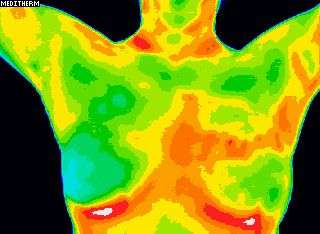Digital Thermography
DITI is a non-invasive diagnostic technique that allows the examiner to visualize and quantify changes in skin surface temperature.
 DITI (Digital Infrared Thermal Imaging or Thermography) is a non-invasive diagnostic technique that allows the examiner to visualize and quantify changes in skin surface temperature. An infrared scanning device is used to convert infrared radiation emitted from the skin surface into electrical impulses that are visualized in color on a monitor. This visual image graphically maps the body temperature and is referred to as a thermogram.
DITI (Digital Infrared Thermal Imaging or Thermography) is a non-invasive diagnostic technique that allows the examiner to visualize and quantify changes in skin surface temperature. An infrared scanning device is used to convert infrared radiation emitted from the skin surface into electrical impulses that are visualized in color on a monitor. This visual image graphically maps the body temperature and is referred to as a thermogram.
DITI's role in breast disorders is to help in early detection and monitoring of abnormal physiology and the establishment of risk factors for the development or existence of disease. When used with other procedures, the best possible evaluation of breast health is made.
15 Minute, Non-invasive Test
This 15 minute non-invasive test is a valuable procedure for alerting your GP or specialist to the possibility of underlying breast disease. This test is designed to improve chances for detecting fast-growing, active tumors in the intervals between mammographic screenings or when mammography is not indicated by screening guidelines for women less than 50 years of age. A patient's thermograms (breast images) are kept on record and form a baseline for all future routine evaluations. DITI is especially appropriate for younger women between 30 and 50 whose denser breast tissue makes it more difficult for mammography to pick up suspicious lesions. This test can provide a 'clinical marker' to the doctor or mammographer that a specific area of the breast needs particularly close examination. The faster a malignant tumor grows, the more infrared radiation it generates. For younger women in particular, results from DITI screening can lead to earlier detection and ultimately, longer life.
Pinpoint the Source of Pain
Pain in the body shows up as Hyperthermia (hot spots: red and white) or Hypothermia (cold spots: blue, purple, and black) indicating to the client and/or practitioner a vascular or nerve problem within the body. The spectrum of colors indicates an increase or decrease in the amount of infrared radiation being emitted from the body surface. Since there is a high degree of thermal symmetry in the normal body, subtle abnormal temperature asymmetries can be easily identified. Used as a preventative tool, DITI can be a wonderful resource for vascular problems and carotid arteries. TMJ, infected root canals, and gum disease can also be indicated by thermography.
Helps with Monitoring and Early Detection
As well as pinpointing the source of pain, DITI can also monitor the healing process before the patient is returned to work or training. Inflammation is a precursor to many diseases such as cancer, arthritis, heart disease, stroke, diabetes and high blood pressure. Heat patterns indicate inflammation, which is precursor to disease in the body and directly correlates with other diagnostic tests. Early detection of inflammation is critical - you can prevent or intervene in the development process before it turns into disease. Inflammation can also be reduced by dietary changes, supplements, detoxification, stress-reduction, massage and acupuncture. Measuring inflammation through thermal imaging on a consistent basis can also be very effective at detecting the severity of a medical condition.
